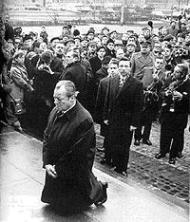Germany has repented too little, too late and forced by other countries
25SEP
Rate This
If a person looks at the performance of Germany regarding their crimes in WWII that are unmatched in humanity, we note the following facts :
- The definitive treaty of boundaries, between Poland and the united Germany was signed in Warsaw, the November 14, 1990
- On December 7, 1970, West German Chancellor Willy Brandt travelled to Warsaw, Poland and dropped to his knees before the monument to the Warsaw Ghetto uprising of 1943. Some Germans questioned Brandt’s actions. The cover of the popular German magazine “Der Spiegel,” which came out one week later, posed the question, “Should Brandt have kneeled
Over 60% of Germans considered Willy gesture Brandt “exaggerated”. We are talking in 1970. when the murderers who killed women and children in Warsaw were mostly 40-60 years and lived happily and peacefully in Germany.
- More than 4000 cities in Germany and Austria, appointed Adolf Hitler as the city’s favorite son, many have not withdrawn that honor as Amstetten, Bad Kissingen, Regensburg, Trostberg, Nuenburg von Wald y Landsber am Lech in Baviera, Chemnitz in Sajonia, Bül and Kirchardt in Baden, Gau-Odernheim in Hesse, Hirsau in Württemberg, Zwickau, Kevelaer, Leipzing, Radebeul and Oelsnitz in Sajonia. Lüdenscheid in Westfalia, Wuppertal in Renania, and many others.[1]
- Few people know that Germany benefited from a generous debt relief at the beginning of its economic miracle. The London Agreement on German Debt, February 27, 1953, is an early and little-known modern example of sovereign debt restructuring, which is very surprising considering its effectiveness in recovering the debt sustainability German (Western ). Towards the end of the negotiations, was canceled half of all debts of 30 million and the remaining frames were rescheduled so cleverly that Germany never again had to deal with a debt problem.
The German children tend not to learn anything of the Agreement in their history classes and the media not given much consideration. However, today it would be wise to remember how they prevented an imminent state bankruptcy through appropriate negotiations, fast, comprehensive and fair.
1. What is the London Agreement on Debt ?
The February 27, 1953 was signed ‘ London Agreement on Debt ‘ extraordinary pact which canceled many of the debts that Germany had contracted before the war . The uniqueness of the agreement comes from the fact that its signatories were countries that had been at war just a few years before : first , the new and heavily indebted German Federal Republic ( successor to Hitler ‘s Germany ) and , on the other, its creditors , the Western Allies , led by the UK , France and the United States.
2 . What part of German debt was canceled ?
Destroyed by the war, Germany was unable to pay its external debt during the war. Despite some previous agreements to reduce its debt after the war, before the conflict debts were still enormous and unpayable . Around 50% of German debt was canceled , which meant about 30,000 million marks or 150% of exports , 1950 . With respect to the remainder of German debt , even was granted additional relief with a reduction of interest in different aspects. The London Conference adopted a comprehensive solution to address the remaining debts of Germany, relating to two constituent parts :
Loans that Germany had taken during the WeimarRepublic to meet the service agreements of the Treaty of Versailles of 1919 , which had already been postponed twice and then were partly canceled. Moreover , the debts of other public and private debtors totaled 5,800 million German marks, so as to set and discussed all prewar debts , which involved a total of 13,500 million marks.
Loans that the federal government had received from the Western powers , especially the United States, to finance reconstruction after the Second World War.[2]
That is, countries where only eight years before the Germans were killing their women and children, burning entire villages as in Greece or Italy, largely spared their debt to Germany, which made possible the so-called “German miracle”, better said that “ The miracle of the merciful of their European víctlms”. Sadly, most of the countries that forgiven debt to Germany did forced by the United States that wanted to strengthen Germany as an ally against the Soviet Union, thus avoiding putting more troops in Europe.
- The German Foreign Office Since 1950, when Dr. Adenauer began to organize it in Bonn was formed n that nearly all key positions in Dr. Adenauer’s ForeignOffice were staffed with Nazi diplomats who had played a prominent role in the preparation of Hitler’s aggressive warfare and who had even participated in planning and executing the mass extermination of the Jewish population in European countries. Among the diplomats named by the Frankfurter Rundschau were: Dr. Hans Globke, Dr. Theodore Kordt, Dr. HerbertBlankenhorn, Dr. Emil von Rintelen, Dr. Werner von Grundherr, Dr. Gottfried von Nostitz, Dr. Herbert Schwartzman, Hasso von Etzdorff, Dr. Albrecht von Kessel, Heinz Tmetzschler von Falkenstein, Dr. Werner von Bargen, and many others.
On October 16, 1951, Dr. Adenauer had to admit in the Bundestag that among the 383 officials and employees in his Foreign Office, 134 were former Nazi Party members, and 158 had served under von Ribbentrop. An investigating committee of the Federal Parliament admitted that some of the Nazi diplomats had such a black record that they regarded them as “absolutely inadmissible” to any position in the diplomatic service. It seems that the percentage figures which Dr. Adenauer had given to the Federal Parliament had been kept rather low, for on March 17, 1952 the Associated Press reported from Bonn Setting the Trap 161 that a German radio commentator declared that 85% of the personnel in Adenauer’s Foreign Office were former Nazis.[3]
Of course it was with the knowledge of the U.S. and tolerated by them, See “Operation Paper Clip”
That is, the foundations of the modern German secret service were Nazis at 85%, Do strange that current Turkish murders were ignored for years by those same services recently ?
- Germany did not punish the vast majority of genocides and still making it difficult to judge and condemn those who are found by foreigners.
One example among hundreds of thousands:
Max Merten, responsible for the slaughter of more than 40,000 Jews in Thessaloniki, lived quietly in Germany until, in the fifties, made the mistake of travelling to Greece. He was arrested, but r Athens eleased him in return of German economic aid.
According Clogg, when Merten returned home, “was compensated by the German Government for the time he spent in jail in Greece”. [4]
- Many Germans were Nazis years after the war, even supporters increased. The denazification was largely a failure.Thus in April 1951, at the height of the rightist revival, U.S. High Commissioner John J. McCloy warned that the threat posed by former Nazi activists was “sinister,” and that… in certain areas of Germany small groups are again trying to spread the evil doctrines, the old slogans and tactics, which brought Germany to ruin and will do so again if they should ever prevail. The German people, through their democratic governments, must be aware of these developments and be prepared to deal effectively with them.Such words could be taken as added proof that no real change of heart had occurred in a substantial segment of the population, that “reeducation” was permanently ailing and had not much of a chance in the future.Quite apart from the semblance or reality of political participation, there is evidence culled from contemporary popular opinion polls that can only corroborate such an impression. In retrospect, it is not certain which of two problems was the greater one, a studied ignorance of the ignoble past or an outright confession in its favor. In the American Zone in 1946, about 57 percent of men and women surveyed were satisfied with denazification, but only 32 percent were in 1948, and 17 percent in 1949. By 1953 there were 40 percent who actually thought denazification harmful..Against this background, the increased expressions of pro-Nazi sentiment is hardly surprising. In the Western zone as a whole, 40 percent of persons polled conceded in 1946 that National Socialism had been “a good idea, just not well executed”; while 55 percent said this in 1948.Further, between May 1951 and December 1952 the proportion of those who recognized “more good than bad” in Nazism rose from 34 to 44 percent, and in July 1952 a full third of the Federal Republic’s citizens still acknowledged some form of admiration for the Fuhrer.(5)


No comments:
Post a Comment